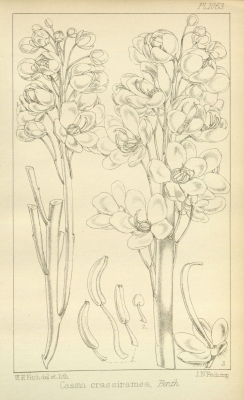Senna crassiramea
(Benth.) H.S.Irwin & Barneby
Fabaceae
Cassia crassiramea Benth.
Common Name:
General Information
Senna crassiramea is a shrub.
The plant is sometimes harvested from the wild for local use in making brooms.
Known Hazards
None known
Botanical References
Range
S. America - Argentina, Bolivia.
Habitat
Clear, xerophytic low forest or shrubland at elevations from 2,300 - 3,150 metres in Bolivia.
Properties
| Other Uses Rating |      |
| Habit | Shrub |
| Height | 0.00 m |
| Cultivation Status | Wild |
Cultivation Details
A plant of higher elevations in the drier tropics and subtropics, being found usually at elevations above 2,000 metres. It is found in areas where the mean annual temperature is around 18.5°c and the mean annual rainfall is around 290mm[
536- Title
- Novon Vol.4
- Publication
-
- Author
-
- Website
- http://www.biodiversitylibrary.org
- Publisher
- Missouri Botanical Garden; Missouri.
- Year
- 1994
- ISBN
-
- Description
- A botanical magazine, focussing on publishing new and amended names of species. It can be downloaded from the Internet.
].
Although many species within the family Fabaceae have a symbiotic relationship with soil bacteria, this species is said to be devoid of such a relationship and therefore does not fix atmospheric nitrogen[
755- Title
- Nodulation Plants in GRIN Taxonomy
- Publication
-
- Author
-
- Website
- http://www.ars-grin.gov/~sbmljw/cgi-bin/taxnodul.pl?language=en
- Publisher
- United States Department of Agriculture
- Year
- 0
- ISBN
-
- Description
- An online database listing plants that have either positive or negative reports on root and stem nodulation with nitrogen-fixing bacteria.
].
Edible Uses
None known
Medicinal
None known
Other Uses
The twigs are used for making brooms[
46- Title
- Dictionary of Economic Plants.
- Publication
-
- Author
- Uphof. J. C. Th.
- Publisher
- Weinheim
- Year
- 1959
- ISBN
- -
- Description
- An excellent and very comprehensive guide but it only gives very short descriptions of the uses without any details of how to utilize the plants. Not for the casual reader.
].
Propagation
Seed - it has a hard seedcoat and may benefit from scarification before sowing in order to speed up and improve germination. This can usually be done by pouring a small amount of nearly boiling water on the seeds (being careful not to cook them!) and then soaking them for 12 - 24 hours in warm water. By this time they should have imbibed moisture and swollen - if they have not, then carefully make a nick in the seedcoat (being careful not to damage the embryo) and soak for a further 12 hours before sowing.
If you have any useful information about this plant, please leave a comment. Comments have to be approved before they are shown here.


 Useful Tropical Plants Database 2014 by
Ken Fern,
web interface by
Ajna Fern
with help from
Richard Morris.
Useful Tropical Plants Database 2014 by
Ken Fern,
web interface by
Ajna Fern
with help from
Richard Morris.